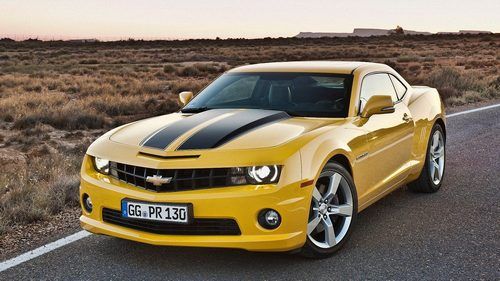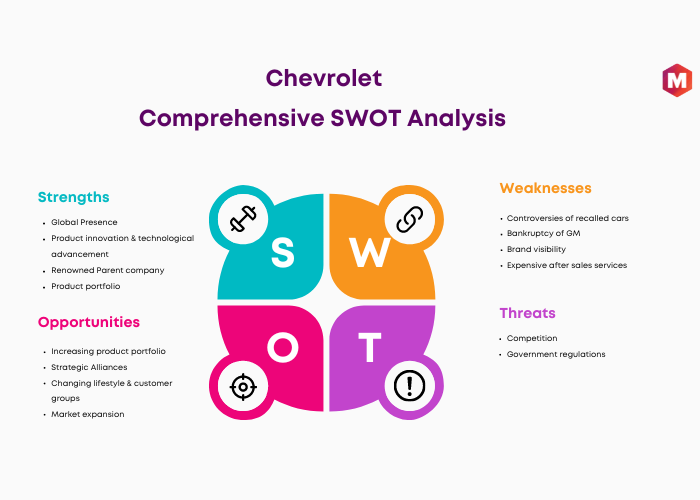
Let’s explore the SWOT analysis of Chevrolet by understanding its strengths, weaknesses, opportunities, and threats.
Chevrolet, founded in 1911 by Louis Chevrolet and William C. Durant, is one of the most recognizable American automobile companies. With a century-long history, Chevrolet has established itself as a global emblem of dependable performance, innovation, and affordability. The company takes pleasure in offering a diversified portfolio of vehicles ranging from compact cars to trucks and SUVs, all designed to fulfill the varying needs of consumers worldwide.
Chevrolet, known for its commitment to quality and customer satisfaction, continues to grow in response to technological breakthroughs while keeping its tradition of providing vehicles that combine style and functionality. Chevrolet is one of General Motors’ flagship umbrella brands.
Overview of Chevrolet:
- Industry: Automotive
- Founded: November 3, 1911, 112 years ago
- Founder: Arthur Chevrolet, Louis Chevrolet, William C. Durant
- Fate: Acquired by General Motors in 1918
- Headquarters: Detroit, Michigan, U.S.
- Key people Alan Batey (SVP)
- Parent: General Motors
- Website: chevrolet.com
Table of Contents
SWOT Analysis of Chevrolet
Strengths of Chevrolet
1. Global Presence
According to Chevrolet data, the company operates in 200 countries. The USA is its hottest market, where it sells the highest number of Chevrolet cars compared to any other nation worldwide. Developing nations like China and India are emerging markets where the company is trying hard to establish itself. It manufactures vehicles in 37 countries under 13 brands.
2. Product innovation & technological advancement
Chevrolet has more than 100 years of history, from participating in championships with its Sports cars (NASCAR, INDYCAR, and the FIA World Touring Car Championship) to introducing Hybrid models like the Chevrolet Malibu and Tahoe (in the US market). The company also invests in hybrid and plug-in vehicles for cars and trucks.
3. Parent company General Motors is a renowned brand in the automotive industry
GM owns 13 brands, including Chevrolet, GMC, Cadillac, Buick, Opel and many others. It is currently among the world’s largest automakers in terms of vehicle unit sales.
4. Product portfolio
It has a presence in all the segments, from hatchbacks to sedans to SUVs. They are also in Commercial vehicles like buses & trucks.
5. Workforce
It has created a pool of 300,000+ highly skilled employees continuously working in 100+ countries.
6. US market
Although GM’s sales declined by a quarter percentage in the US after its bankruptcy, the company started aggressively targeting Asian markets like China, India, etc., which have lots of potential, and that’s how they are again on a positive growth rate.
Weaknesses of Chevrolet
1. Controversies of recalled cars
Controversies about recalled cars on account of faulty ignition switches have been linked to at least 13 deaths, at a loss of $1.3 billion. News like this is affecting its brand image.
2. Bankruptcy of GM
After a lot of decline, GM was finally brought to its knees by the recession (2008-09) and frozen credit markets, forcing the company into the arms of the federal government. It was even removed from the Forbes 500 list of companies on account of filing for bankruptcy. All these events affected the brand image of the group companies.
3. Brand visibility
One of the most important departments that the GM group of companies is struggling with now is advertising, which results in low visibility across various mediums compared to competitors.
4. Expensive after-sales services
After-sales service is one of the major factors affecting the buying decisions of customers in the automobile industry. Chevrolet has expensive after-sales service with high prices of spare parts as compared to other players in the same segment, which affects the buying decisions of the customers
Opportunities of Chevrolet
1. Increasing product portfolio
By increasing its product portfolio and introducing new series in different segments, Chevrolet can increase their sales as customers will have more choices under the same brand.
2. Strategic Alliances
Chevrolet has very few strategic alliances with other companies. It can enter into strategic alliances to design/redesign their offerings.
3. Changing lifestyle & customer groups
Changing customer lifestyles and the emergence of more nuclear families needing a car for their small families can increase car demands.
4. Market Expansion
Entering new markets and further penetrating developing markets like India, China, etc., will help the company increase its revenues.
5. Strengthening commercial vehicle business
The market volume is expected to be 29 million units by the end of 2015. Increasing awareness and an upsurge in the use of public transportation will contribute to its steady growth rate even if the passenger car business faces a slowdown.
Threats of Chevrolet
1. Competition from other automobile players
Other automobile giants compete fiercely for passenger and commercial vehicles. Competition is huge in this industry, and nothing hurts a company more than internal strife, maybe from group companies themselves.
2. Government regulations
Government policies/regulations, such as reducing global warming by discouraging the use of personal transportation, reducing road permit validity, reducing fuel price volatility, and restricting the entry of outside-state vehicles, are being implemented in respective regions around the world and are affecting the sector broadly.
Conclusion:
Finally, Chevrolet is a steadfast symbol in the automobile business, owing to its global presence, diverse product line, and technical breakthroughs. Despite prior problems and fierce competition, Chevrolet continues to seize chances by extending its product lines, entering new markets, and boosting its commercial vehicle segment.
With General Motors’ backing and a century-long tradition of innovation, Chevrolet is well-positioned to overcome regulatory challenges and preserve its position as a global leader in supplying dependable and creative automobiles. As it adjusts to evolving consumer tastes and market conditions, Chevrolet’s dedication to quality and customer satisfaction remains key to its long-term growth and success plan.
Liked this post? Check out the complete series on SWOT
